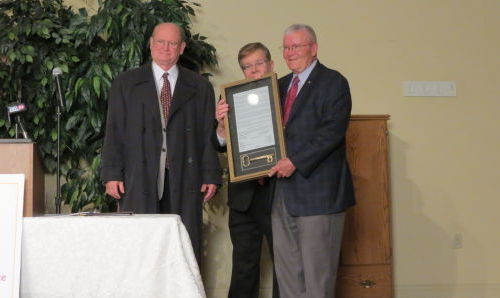
Haise encourages students at TFAE banquet
February 13, 2014CRIME BLOTTER: Reported offenses in the Tri-parish area
February 13, 2014Kerry St. Pé, leader of the Barataria-Terrebonne National Estuary Program for more than 16 years, will retire this summer.
St. Pé informed BTNEP’s management conference Feb. 6 that he’d step down in July. He will leave an organization that compounds myriad opinions regarding coastal issues to advocate for and implement projects based on the consensus of stakeholders from all backgrounds.
“It certainly hasn’t been an easy decision,” St. Pé said. “It is kind of emotional and a very difficult decision to leave. It’s always hard to leave a program you’ve spent so much time building, but I’m leaving it with good people, a good staff that will carry on the traditions of what the estuary program is all about. … It can get very frustrating, and I need to turn it over to a younger guy or gal that can move things forward.”
St. Pé does not have a subsequent job lined up, he said.
BTNEP, as one of 28 national estuary programs established by Congress, conducts research, restoration projects and outreach events to draw awareness to and help solve issues in the Barataria and Terrebonne basins. It oversees 4.2 million acres between the Atchafalaya and Mississippi river basins.
Guiding the estuary program is the Comprehensive Conservation Management Plan, which includes a 51-point strategy to address ecological and economic issues, public awareness and project implementation. The plan was enshrined in 1996, and the management conference must affirm it quarterly.
The Barataria-Terrebonne Estuarine System stretches from Terrebonne to Plaquemines parishes and is at the crux of Louisiana’s coastal woes. BTNEP’s essence is to act as a sort of clearinghouse for ideas and initiatives in this area, one whose protection is important culturally and economically.
With five months remaining in his tenure, St. Pé was blunt when summing up the state of coastal issues, primarily erosion versus restoration and preservation.
“We’re losing the battle,” St Pé said. “We’re restoring land here and there, but we’re not keeping up with the loss rate. We need to exceed the loss rate. We need to have a net gain in the wetlands.”
Observers lauded St. Pé’s integrity and commitment to protecting the coast, even when his voice has bisected to the wants of other coastal advocates. Whether he is expressing dissent, caution or calling attention to a new angle related to an initiative, St. Pé said, he is beholden only to the program’s guiding document.
“I completely believe, completely, in the CCMP, and the CCMP, I think, is the last hope for our people,” St. Pé said. “It’s my job to make sure that’s implemented, regardless of politics.”
St. Pé became BTNEP’s director in 1997 after chairing its scientific-technical committee during the formative years from 1991-96. Prior to taking the full-time position, St. Pé was a field biologist and regional coordinator for Water Pollution Control Division of the state departments of Wildlife and Fisheries and Environmental Quality.
Upon its foundation, BTNEP was led by Steve Mathies, who St. Pé said was on loan from the U.S. Army Corps of Engineer. After Mathies left, an interim director was appointed, but that director served the governor’s office and BTNEP did not receive full devotion.
The staff dwindled to one person and the program “essentially died,” St. Pé said. He stepped in, also on an interim basis, and began interviewing and hiring staff members. Finally, Mathies’ ongoing pleas to St. Pé to take the directorship set in.
“It’s not that I felt my previous job wasn’t important, but the estuary program consolidated all issues into one plan and it was very, very important that plan be implemented,” St. Pé said.
BTNEP’s research covers an array of estuary issues, including the impact of toxic substances, sediment reduction and hydrologic modification. BTNEP’s outreach programs include La Fête d’Ecologie, Paddle Bayou Lafourche and the Grand Isle Migratory Birds Celebration on an annual basis.
And the estuary program has undertaken restoration efforts on its own, soliciting grants and private funding to work toward restoring marshes.
St. Pé said the program has implemented “hundreds and hundreds” of projects, which is a credit to the staff, 11 members excluding the director.
“We’re very, very busy in the estuary program,” he said. “It takes a good staff, an excellent staff to implement all of that. I think my biggest accomplishment has been to populate this program office with the finest staff anybody could ask for.”
David Muth, director of the National Wildlife Federation’s Mississippi River Delta Restoration Program, said St. Pé brought a passion and dedication to his job, but more importantly, the estuaries in which he lived.
“Kerry will be missed,” Muth said. “He was just a great, great guy to work with. I mean that. He really was. Whether you agreed 100 percent of the time or disagreed, you couldn’t help engaging with him.”
Simone Maloz, executive director of Restore or Retreat, a nonprofit group advocating on behalf of the Barataria and Terrebonne basins, said it’s important BTNEP maintains an active role as the state moves toward implementing projects in its 50-year master plan.
“Kerry has (left) very big shoes to fill,” Maloz said. “That is going to take a great leader who continues to move them forward and make sure we’re adapting to the current atmosphere in restoration. … Kerry always fought for what he thought was best in this area, and we’re losing a passionate champion in that respect.”
Both Maloz and Muth labeled the CCMP-building process as a first for coastal Louisiana that still influences how issues are considered statewide. Although it represented widespread consensus 17 years ago now could be the time to re-evaluate BTNEP’s guiding document, they said.
“Obviously there’s been a tremendous amount of things that have happened, a tremendous amount of new science, a tremendous amount of land loss, a tremendous of planning and government action that’s taken place since the CCMP was written, so I would assume it’s probably a good time to think about revision,” said Muth, who helped draft the document.
South Lafourche Levee District Executive Director Windell Curole said BTNEP under St. Pé has done an admirable job in consolidating often extreme-opinions. When discourse becomes polarized, ideas in the middle are often pushed aside.
“It’s not about environment in place of one thing,” Curole said. “It’s about making it make as much sense as possible. It should all work together. (South Louisiana) is forced to make it work together more than most people.”
The Louisiana Universities Marine Consortium oversees BTNEP on the state level. Nancy Rabalais, LUMCON’s executive director, said St. Pé has done “an incredible job” as the program’s chief, particularly in terms of building consensus and faithfully representing the unified opinion.
“He’s fully aware of the complications of the issues involved in resource management, education of the public and the important issues facing coastal Louisiana,” Rabalais said. “He’s done his best to remain open and objective to those decisions, and I think that’s brought an avenue of all points of view to come together and discuss these things.”
BTNEP’s management conference will form a search committee to determine St. Pé’s replacement. Rabalais said she’s already expressed a desire to serve on the committee.
“The program has evolved over the years into a very influential consensus-driven group that works with all levels of society to make good decisions about the resources,” Rabalais said. “I would hope that would continue.”










